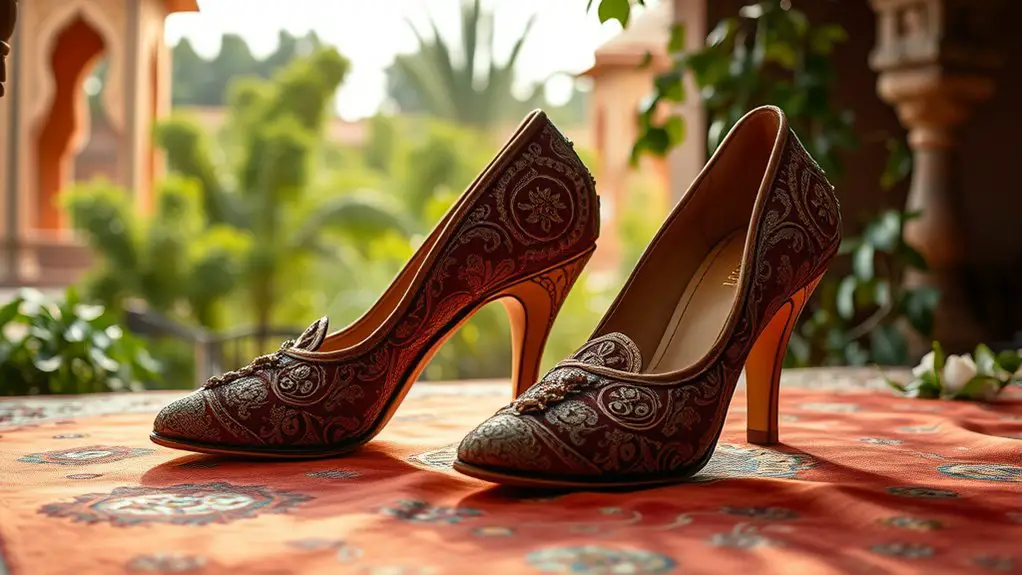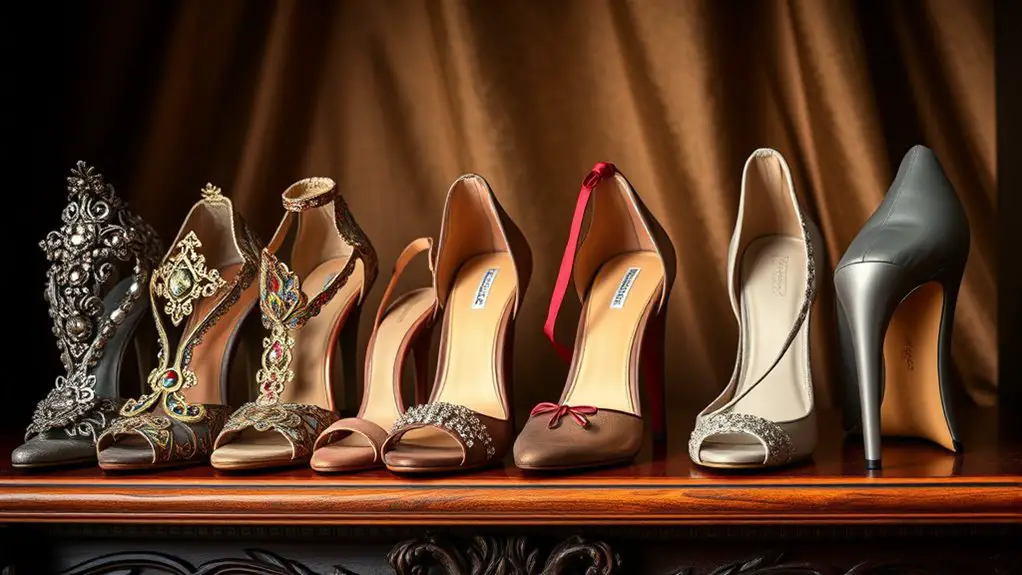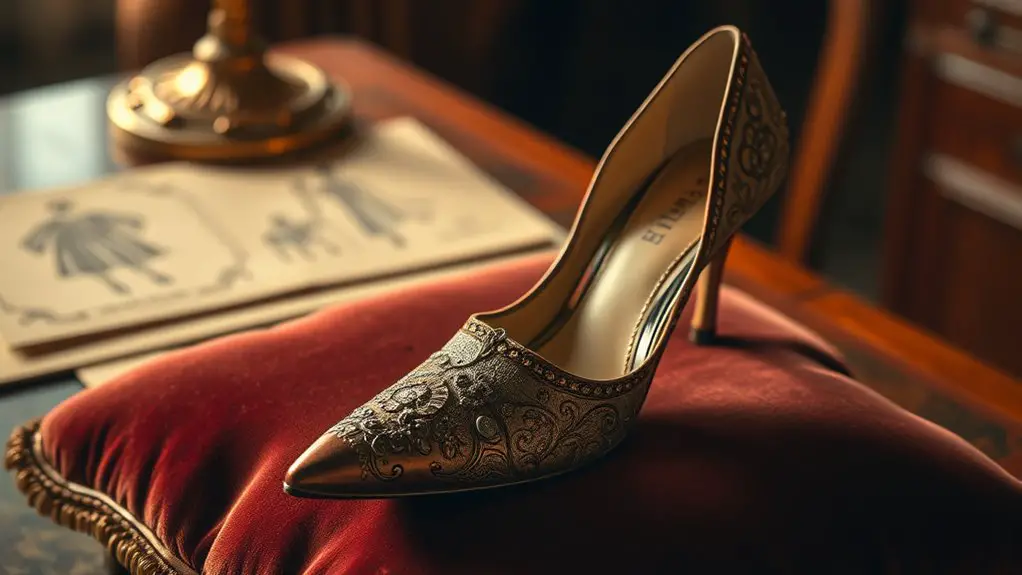High heels were invented in ancient Persia, primarily for horseback riding, providing stability in stirrups. They evolved over time, particularly in Europe, transforming from practical footwear into symbols of status and femininity among the elite. By the 17th century, high heels gained popularity, especially with figures like King Louis XIV endorsing them. Today, they represent a blend of cultural significance and personal expression. There’s much more to discover about their fascinating journey through history.
The Ancient Beginnings: High Heels in Persia

Although high heels are often associated with modern fashion, their origins trace back to ancient Persia, where they served practical purposes beyond mere aesthetics. In this situation, high heels were more than just stylish footwear; they provided stability and support for horse riders, allowing them to secure their feet in stirrups. The Persian origins of high heels reveal a time when functional design was vital, particularly for warriors and nobility engaged in equestrian activities.
These ancient shoes, made from leather and other durable materials, were often elevated to enhance posture and elevate status, reflecting the wearer’s rank. While high heels today carry different connotations, understanding their beginnings in Persian culture highlights a blend of utility and symbolism. This connection between form and function in ancient footwear sets the stage for the evolution of high heels and their role in shaping societal norms, making it essential to appreciate their rich history.
The Rise of High Heels in Europe
As you explore the rise of high heels in Europe, you’ll notice their transformation from practical footwear to a fashion statement among the elite. Early adopters used them not just for style, but to assert social status and power, reflecting broader fashion trends of the time. This shift marked a significant cultural moment, intertwining personal identity with the visual language of aristocracy.
Early Wearers and Purpose
High heels didn’t just emerge as a fashion statement; they served practical purposes for their early wearers in Europe. Initially adopted by ancient warriors, these elevated shoes provided better stability and grip on horseback, enhancing their combat effectiveness. As you investigate deeper into their history, you realize that high heels gradually began to shape gender roles. Men wore them to assert dominance and status, while women later adopted them to enhance femininity and elegance. This shift in usage reflected broader societal changes, where footwear became a symbol of power and class. By understanding these early purposes, you can appreciate how high heels were more than mere accessories—they were tools that influenced both fashion and social dynamics.
Fashion Trends and Influence
The evolution of high heels in Europe marked a significant shift in fashion trends, reflecting changing societal values and norms. As you observe this transformation, you’ll notice that high heels emerged during a time when power dynamics and class distinctions were becoming more pronounced. They weren’t just a fashion statement; they symbolized a broader fashion evolution that catered to the desires of the elite. The intricate designs and elevated heights of heels showcased craftsmanship and exclusivity, influencing the way individuals perceived themselves and others. This societal impact extended beyond mere aesthetics, as high heels became a tool for expressing identity and status. Ultimately, the rise of high heels illustrates how fashion not only reflects but also shapes cultural and social landscapes.
Symbol of Status
Rising above the ordinary, high heels quickly transformed into a powerful symbol of status in European society. Initially embraced by aristocrats, these elevated shoes became synonymous with the social hierarchy, distinguishing the elite from the masses. You’d notice that wearing high heels signaled wealth and sophistication, as they required skill and resources to craft. Over time, they evolved into a bold fashion statement, further solidifying their place in luxurious wardrobes. The higher the heel, the greater the status, reflecting not just personal style but also societal power dynamics. As you navigate through history, it’s clear that high heels transcended mere footwear; they became an essential element in the performance of identity and class within European culture.
High Heels as a Symbol of Status
High heels have long been associated with royalty and nobility, marking a clear distinction between social classes. When you consider their historical context, these shoes not only represent wealth and power but also reflect the cultural values of the society that embraced them. Understanding this symbolism reveals how fashion can serve as a powerful indicator of one’s status throughout history.
Royalty and Nobility Fashion
Throughout history, high heels have transcended mere footwear to become potent symbols of status and power, particularly within royalty and nobility. You’ll notice that royal footwear often featured elaborate designs, elevating the wearer’s stature—both literally and figuratively. High heels were not just practical; they embodied noble elegance, showcasing wealth and refinement. Monarchs and aristocrats wore them to communicate their elevated social positions, setting trends that would ripple through society. The height of the heel signified not only physical elevation but also a moral and social superiority, aligning with the hierarchical structures of their time. In this way, high heels became essential elements of the royal wardrobe, reinforcing the allure of nobility and the significance of their fashion choices.
Wealth and Power Representation
In the domain of fashion, high heels serve as a striking representation of wealth and power, transcending their original purpose as mere footwear. They symbolize a luxury lifestyle, often associated with elite status and power dynamics. By wearing high heels, individuals project confidence and sophistication, creating a visual hierarchy in social settings.
Consider these aspects of high heels as status symbols:
- Exclusivity: Limited editions and designer labels enhance their allure.
- Heightened Presence: Elevation adds to one’s stature, both literally and figuratively.
- Cultural Associations: Linked to femininity and empowerment, they signal strength.
- Social Significance: Wearing high heels often indicates affluence and success in various professional arenas.
Ultimately, high heels encapsulate a complex interplay of status and ambition.
Cultural Significance in Society
The cultural significance of high heels extends far beyond their aesthetic appeal, intertwining with notions of status and identity in modern society. You’ll notice that high heels often embody feminine identity, reflecting societal expectations regarding beauty and professionalism. When you wear high heels, you’re not just making a fashion statement; you’re also maneuvering through complex social dynamics that associate elevated footwear with power and sophistication. This connection can reinforce traditional gender roles, suggesting that femininity is tied to certain standards of appearance. However, high heels can also serve as a form of empowerment, allowing individuals to assert their identity and defy conventions. In this way, high heels remain a potent symbol of status, challenging and conforming to societal norms simultaneously.
The 17th Century: The Golden Age of High Heels
During the 17th century, high heels emerged as a symbol of status and sophistication, capturing the attention of both aristocrats and commoners alike. This period marked significant fashion innovations that transformed societal perceptions of footwear. High heels weren’t just about height; they conveyed power and wealth.
Key factors contributing to the golden age of high heels included:
- Royal endorsement: Influential figures like King Louis XIV popularized high heels, making them a must-have accessory.
- Craftsmanship: Skilled artisans created intricate designs, enhancing the aesthetic appeal of heels.
- Material variety: Luxurious fabrics and embellishments elevated their status.
- Gender roles: Both men and women wore heels, challenging traditional fashion norms.
As high heels became synonymous with elegance, they shaped the way society viewed class and style, setting the stage for their enduring legacy in fashion.
The Evolution of High Heels Through the Ages

While fashion trends constantly shift, high heels have consistently evolved, reflecting societal changes and cultural influences throughout history. Initially, high heels were practical, designed for horseback riding to provide stability. As they transformed into symbols of status, design innovations became prominent, with styles varying from the ornate heels of the Baroque period to the sleek silhouettes of the Victorian era.
Throughout different epochs, societal perceptions shaped the use of high heels; they became associated with femininity, power, and allure. In the 20th century, heels morphed again, influenced by women’s liberation movements and changing fashion ideologies. Designers began experimenting with materials and forms, pushing boundaries while maintaining a connection to their historical roots.
As you explore this evolution, notice how each era’s ideals and values are encapsulated in the changing designs of high heels, illustrating the complex interplay between fashion and society.
High Heels in the Modern Era
How have high heels adapted to the complexities of modern life? In today’s fast-paced world, high heels have become more than just a fashion statement; they reflect societal shifts and personal expression. The influence of celebrities has played a pivotal role in popularizing trendy styles, making them accessible and desirable to the masses.
Consider these key adaptations:
Key adaptations of high heels include comfort innovations, versatile designs, sustainable materials, and inclusivity for a modern audience.
- Comfort Innovations: Brands are now incorporating ergonomic designs and cushioned insoles.
- Versatile Designs: High heels are available in various styles, suitable for both professional and casual settings.
- Sustainable Materials: Eco-conscious consumers demand heels made from sustainable resources.
- Inclusivity: Many brands are expanding their size offerings to cater to a wider audience.
These changes demonstrate how high heels have evolved to meet the demands of modern wearers, blending style with functionality while maintaining their iconic status.
Cultural Variations of High Heels Worldwide

As high heels traverse cultural landscapes, they take on distinct meanings and styles that reflect local traditions and societal values. In Japan, for example, the traditional “geta” showcases an artistic expression of footwear that elevates the wearer while connecting to historical practices. Conversely, in Western societies, high heels often symbolize power and femininity, influenced by societal perceptions of gender roles.
You’ll find global styles ranging from the sleek stiletto to the chunky platform, each representing regional differences and historical variations. In parts of Africa, high heels are sometimes worn during ceremonial events, highlighting their cultural significance within community practices.
These variations reveal how high heels are not just fashion statements; they serve as cultural artifacts that encapsulate the complexities of identity, status, and artistry across the globe. Ultimately, high heels reflect a rich tapestry of human experience, transcending mere aesthetics.
Frequently Asked Questions
Were High Heels Originally Designed for Men or Women?
High heels were originally designed for men, reflecting men’s fashion trends of the time. Over time, they evolved into symbols of women’s empowerment, allowing women to assert confidence and challenge societal norms through stylish elevation.
How Have High Heels Impacted Foot Health Over Time?
High heels can be like a double-edged sword, providing elegance while causing foot discomfort. Over time, their long-term effects can lead to issues like bunions and plantar fasciitis, impacting overall foot health considerably.
What Materials Were Used in Early High Heel Construction?
In early high heels, you’ll find leather choices like cowhide or kid leather for durability and comfort, while wood bases provided structural support. These materials reflected both practicality and the fashion sensibilities of the time.
Are There Any Notable High Heel Fashion Trends Today?
Today’s high heel trends reflect dynamic styles influenced by celebrities. You’ll notice chunky platforms, sleek stilettos, and vibrant colors dominating the scene, showcasing how these trendy styles evolve with cultural shifts and celebrity endorsements.
How Do High Heels Differ Across Various Cultures?
High heels differ considerably across cultures, reflecting their unique cultural significance. In some societies, they symbolize status or femininity, while global variations showcase diverse styles, materials, and designs, revealing deep-rooted traditions and contemporary influences shaping modern fashion.



